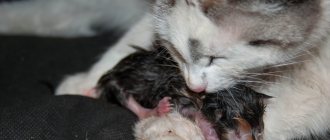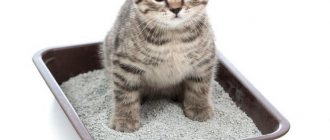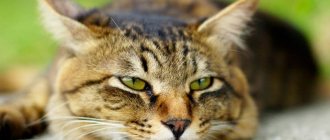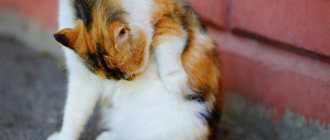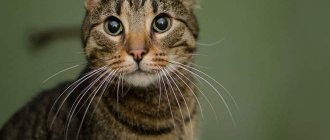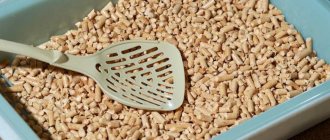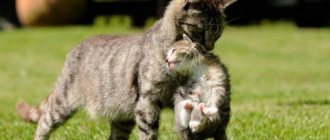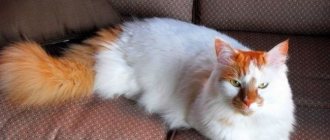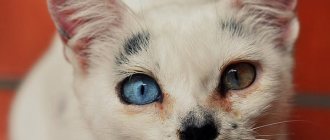The appearance of a small purring pet in a family becomes a joyful event that will bring many positive emotions in the future. However, there will also be a lot of worries: the baby must be accustomed to the norms of behavior in an apartment or house, and his regime must be controlled.
The most difficult moment for many owners is teaching a cat to use a litter box. It is at this moment that you can notice that the animal is eating the mixture from the toilet. There is no need to panic - you need to find out the reasons and apply conditions to eliminate them.
Why does a kitten eat litter?
It would seem that the filler, be it clay, wood or silica gel, can hardly attract with its taste... However, as they say, there is no arguing about tastes. Some fragrances with which the litter is flavored may seem so attractive to the kitten that he will risk trying the inedible substance “on the tooth.” And you know, he might like it, after all, some people also like very strange things... moonshine, for example.
But more often than not, it happens differently. When playing, kittens, like children, put everything in their mouths. But if the string or candy wrapper can be freely released from the mouth, then the filler, especially clumping one. Sticks tightly to the tongue or palate. And the poor baby has no choice but to try to swallow the interfering lump.
How often to change?
The time of use for each filler may vary, which will primarily depend on the type of material used. In addition, this may depend on the number of pets living in one house (the more there are, the more often the granules in the tray will have to be changed). In this case, the material can be partially recycled. For example, wood filler pellets that have been exposed to large amounts of cat urine will crumble.
They can be separated from the whole granules with a spatula and thrown away. If there is a lot of spilled material, then it is necessary to replace it completely, pouring a fresh portion after washing and drying the box.
If you do this less often, an unpleasant odor will spread throughout the house, and the pet itself will look for another place for the toilet. Raw materials containing mineral components are disposed of all at once: in this case, there is no point in gradual replacement. The key point when changing material is to wash the tray and mesh with a cleaning agent - this will neutralize the unpleasant odor and get rid of pathogens.
Silica gel can be used for two weeks. After this, the used material is replaced with new one. However, this does not mean that you need to wait two weeks without touching the tray. Used lumps with absorbed liquid must be eliminated immediately after their discovery. The rest of the mass must be mixed, which will promote rapid drying.
Mineral granules are changed at least once a week, however, if the contamination is severe, the procedure must be performed more often. The mixed litter in the tray should be changed once a week if there is only one animal at home. This is done using a special blade with holes, which will allow you to simultaneously sift the material while separating the waste product. After this, you need to pour fresh granules into the tray.
Sand must be changed daily. This filler is also bad because it can spill out. It is useless to sow, dry or separate it - this will not relieve household members of the smell and grains of sand near the tray. If there are several pets in the house, you will have to remove the litter once every 3-5 days, focusing on the smell emerging from the tray.
Is it dangerous if a kitten eats litter box?
A few swallowed pieces of the filler will not cause any harm to the baby. Undigested remains will safely leave his stomach naturally. The fillers do not contain any poisons.
It is dangerous if the kitten gets a taste of the clumping litter. Once wet in the mouth or stomach, its particles form a dense lump, just like in the tray. And if this lump turns out to be large, it can clog the esophagus and intestines. An urgent operation will be required to save the little sufferer.
Silica gel filler can also be dangerous for a kitten. Its particles have a unique ability to absorb moisture. And a few of these grains, once in the stomach, can cause a lot of unpleasant moments for the baby. In addition, silica gel, when wet, becomes sticky, so grains can stick to the larynx and esophagus, which is not only unpleasant, but also life-threatening.
Why should you contact a veterinarian?
It would seem a trivial situation, the pet seems to be healthy and active in appearance, why do you need to contact a veterinarian? Only a veterinarian will be able to determine what type of vitamins are missing in the pet’s body. The specialist will prescribe exactly those medications that will fill the missing element in your pet. This way, the craving for eating cat litter can subside.
In case of an emergency visit to the clinic, you need to take a box of the mixture with you - this is necessary so that the veterinarian knows what drug he is dealing with and quickly provides emergency assistance to the cat.
If suddenly the cat becomes lethargic, sleepy, inactive, then it is necessary to go to the clinic as soon as possible, at this time every minute of the animal’s life can be precious. Most likely, this mixture did not leave the body and led to intestinal blockage or poisoning. The main symptoms of health problems are the appearance of the following signs: fearfulness, aggressiveness, lethargy, refusal not only from food, but also from water, rapid heartbeat and breathing, drooling.
As soon as the owner notices that the cat has become partial to the mixture from the cat litter box, you should immediately try to stop this activity so that it does not become a habit and does not lead to serious problems with the pet’s health.
What litter is best for kittens?
Fillers made from wood waste are considered the safest and most environmentally friendly. That's what they're called - woody ones. Their granules are quite large and difficult for a kitten to swallow. In addition, wood pellets, when wet, literally crawl apart, turning into fine dust. So, even if swallowed, they will not cause the slightest harm. Another advantage of wood filler is that used wood filler can be flushed down the toilet (at least that’s what the manufacturers say).
There is also a more exotic option - corn filler. It is similar to wood, but is made from corn waste. Absorbs moisture perfectly and retains odors, absolutely harmless, even if the kitten eats it. The disadvantages are the fairly high cost and high consumption. After all, it will have to be changed completely (unlike clumping).
Special fillers labeled “for kittens” are also absolutely safe.
Causes
In order to wean a cat from this habit, you need to clearly understand the reason for its manifestation. Modern veterinarians identify the following main reasons for this behavior in cats.
Physiological – reasons related to the natural needs of pets:
- animals lack minerals and vitamins that enter their bodies with food. Cats, like all other animal species, need various minerals and vitamins for normal functioning. If a person can neglect such needs, then the cat will try to make up for the lack of useful substances from its environment.
- cats are predators by nature. That is why they sharpen their nails and teeth. To minimize their labor costs, they choose to sharpen their teeth what is closest to them. Filler is often chosen as an object for sharpening teeth. Thus, the balls in the silica gel mixture are quite hard and when exposed to them, the teeth are sharpened.
If there is a lack of calcium in a cat’s body , which plays an important role in strengthening and active growth of bones, the pet will try to replenish this substance through the consumption of calcium-containing components, which include litter.
Something with the psyche. Often the reasons for such cat behavior are hidden in the field of animal psychology. Animal psychologists, when explaining the reasons for using filler due to stress and disorders, use such a concept as “food perversion.”
In addition, you must remember that visiting your cat litter box is a way to calm down and feel protected.
How to stop a kitten from eating litter box?
A kitten can chew an inedible object only in one case - it is bored and is looking for something to have fun with. Even if out of curiosity he takes a couple of lumps into his mouth, he will quickly realize that it is not at all tasty.
What should you do if you see your kitten playing with the litter and tasting it? You should not scold your baby, because he is unlikely to understand the reason for your dissatisfaction, and may even begin to be afraid of the tray.
It is better to praise the child and distract him with an interesting game. Have a few balls in reserve (rubber balls from vending machines for 10 rubles apiece are great), shoelaces, hair ties, pieces of crumpled candy foil, and crispy cellophane candy wrappers. Many kittens can play for hours with such a wrapper tied with a regular laundry elastic band. The other end of the elastic band is tied to the door handle. Length – to the floor or slightly shorter. Fun guaranteed for days to come!
What needs to be done
The kitten is sneezing: why and what to do
What to do if your kitten eats litter:
- you need to carefully study the composition of the filler, which causes such interest in the animal. After this, it is necessary to introduce into the diet a vitamin-mineral complex containing substances that are in the filler;
- it is quite possible that the animal simply attracts the owner’s attention in this way. You need to buy your baby more toys and play with him more often;
- To sharpen teeth regularly, you need to give your predator bones or special pieces of calcite. Everything can be purchased at an affordable price in veterinary pharmacies and pet stores. It is recommended to give preference to beef bones, since chicken bones are dangerous to health.
Note! If none of the methods help, it is recommended to purchase another type of filler.
What to do if the kitten stubbornly tries to eat the litter?
There are few options here. The first - radical - abandon the filler completely. A tray with a grid is perfect for such purposes. On the plus side, you no longer have to spend money on buying filler. And the kitten will lose the habit of putting inedible things into its mouth. In addition, cleaning will be easier - there is a lot of dust from the filler, and the kitten will drag its particles throughout the apartment on its paws. And one more thing - you will always know exactly how often the kitten goes to the toilet and control the color, consistency, and smell. The filler quickly teaches owners not to pay attention to such trifles.
There are also disadvantages - you will have to wash the tray much more often. Sometimes - after each use. And the smell - now the aroma will spread throughout the house.
You can avoid the latter if you use filler, just pour it under the grate of the tray. This way, odors will spread much less, and the litter box will have to be cleaned only after pooping, usually 1-2 times a day for kittens. And filler consumption is reduced significantly. And the paws are clean.
Advantages
Silica gel is very popular among cat owners and this is not surprising, because when used correctly it has a lot of advantages:
- efficiency;
- does not generate dust when opening the package and pouring the contents into the tray;
- practically does not stick to the animal’s paws, so there is less dirt from it;
- retains moisture and odor well;
- does not cause allergic reactions in cats.
Anxiety
The cat may start eating the mixture from the tray due to nervousness. If an animal is frightened or depressed, the “stress eating” instinct is triggered as often as stupor, aggression or panic activity. What can cause stress in a pet:
- moving;
- the appearance of a dog in the house;
- the arrival of guests or the arrival of a new family member;
- change of owners;
- sudden change in diet;
- experience of illness;
- increased noise level in the room, etc.
To calm the animal, try to give it attention, caress it, and pamper it with a treat. Let them know that everything is fine and the pet is safe. When moving, offer your cat his favorite toys and feed him from his usual dishes. When new “neighbors” appear, carefully introduce the cat to them and let them get used to it. If you cannot wean your kitten from a strange habit, consult with an animal behaviorist.
How to feed a cat grass
0 Source:
Experts note that the cat itself knows what kind of grass it needs. At the same time, there are plants that can harm the animal. For example, geranium, lily of the valley, yew, daffodils, henbane, violets, oleander, tulip, hellebore and many others. It is unlikely that your cat will start eating them, but it is better to keep her away from this list. If an animal encroaches on potted plants, then it is better for him to purchase normal grass at a pet store. Today there are no problems with this. Sellers may also offer seeds: sprouted sprouts of oats, wheat or mint are likely to appeal to the cat. And in the summer, zoologists emphasize, you can make preparations for the winter: dry the young shoots of plants and store them wrapped in paper. To create the effect of growing grass, you can attach bunches to a stand. In general, if a cat doesn’t want to eat grass at all, then you shouldn’t force him. But if, on the contrary, he absorbs it in large quantities, then this is a reason to contact a veterinarian: perhaps the animal has digestive problems.
Filler selection
To avoid a situation where the kitten climbs into the litter tray and chews on the litter, it is best to purchase wood ones, which are made from waste. It is made in the form of large granules that the animal cannot swallow, and when soaked, the pebbles turn into ordinary dust.
One of the best options is peat toilet filler. It is made in the form of small balls. The filler eliminates kitten stool odors by up to 90 percent. Each granule absorbs liquid 4 times more than it weighs. Used balls can be easily removed from the filler; complete replacement of the entire tray is not required.
The easiest way to prevent your kitten from eating litter product is to simply cover the top with a grill. Then the animal will not be able to reach the filler. In any case, as soon as the kitten begins to eat it, an examination by a veterinarian is necessary.
Previous Question and answer5 reasons why a cat cannot go to the toilet - symptoms and treatment Next Question and answerHow long can a cat not go to the toilet
Grinding of teeth
Another reason for strange behavior is predatory instinct. A cat needs to sharpen its claws and teeth to feel comfortable. Just as he "attacks" furniture to trim his claws, he tries to sharpen his teeth on the hard particles of litter box mixture. The way out of the situation is simple - offer the cat a hard treat in the form of brain bones. Such food will help him sharpen his teeth and bring him pleasure. Typically cats love to chew on beef and pork ribs. But it is better not to give small chicken bones to cats. Feed your cat carefully and monitor his well-being. In case of unusual behavior, you can always call the veterinarian.
In addition, when young kittens are teething, they look for opportunities to stimulate this process. You can buy a special stone for your cat - calcite. It cannot be chewed, but it will effectively help your pet cut and sharpen its teeth.
Do not buy vitamins or any supplements for your cat yourself. Only an animal doctor can accurately diagnose the causes of abnormalities in a pet and recommend safe means to solve the problem.
A game
Sometimes cats try the litter just out of curiosity, trying to figure out what it is. This occurs in small kittens or when changing dry formula. Another reason could be the attractive smell. Some litter scents can fool a cat's instincts and appear attractive. In rare cases, direct behavioral deviations are observed when a cat eats inedible objects for no reason. Due to some organic abnormalities in the brain (for example, after concussions or illness), animals experience some kind of mental disorders.
You can try to wean your cat from chewing the litter by luring him to the feeder with a tasty piece. Take a fragrant treat, such as food or a slice of sausage, and call your cat when he starts to eat the litter. You can also simply change the mixture. There is a chance that the habit will not spread to the new backfill option.
